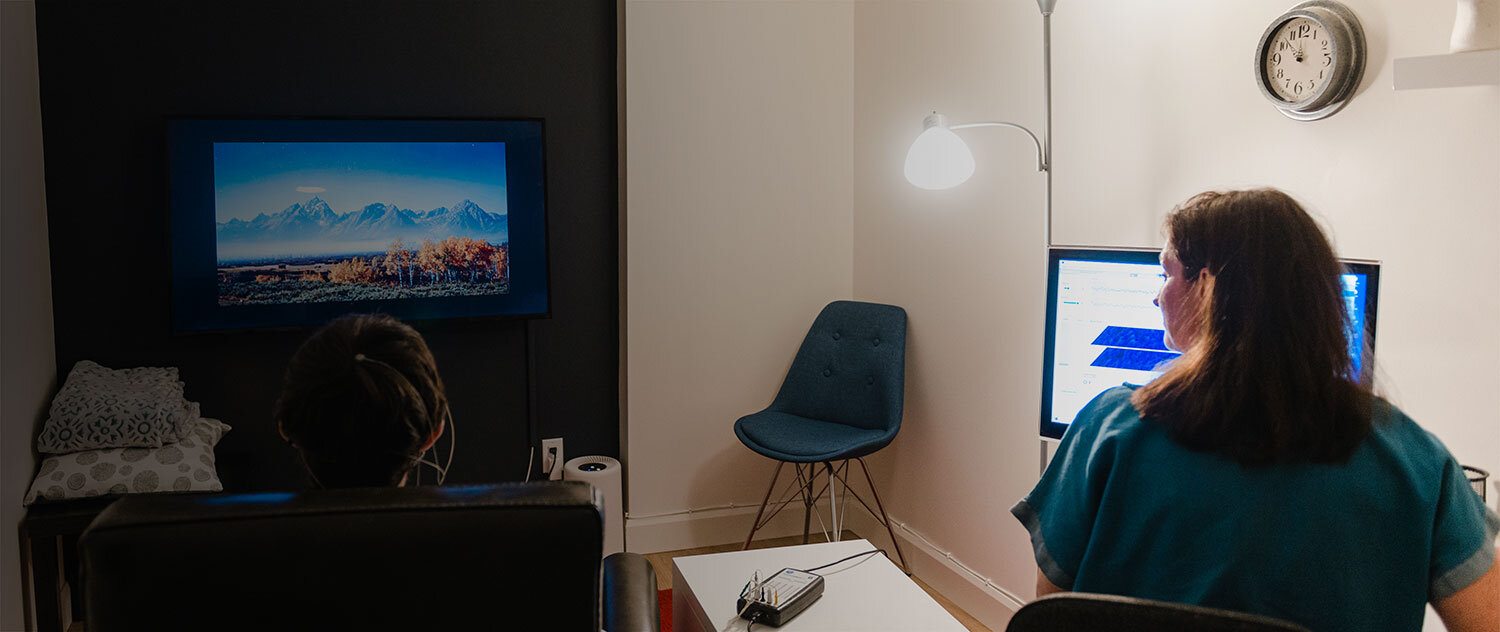
Neurofeedback Therapy
Neurofeedback is a gentle, safe and non-invasive therapy to train the brain to function better and improve your capacity to self-regulate and heal.
What is Neurofeedback Therapy?
Neurofeedback is an evidence-based therapy that is gentle, safe and non-invasive. It works by harnessing neuroplasticity, the brain’s ability to grow and adapt when introduced to new experiences. The goal of neurofeedback is to improve symptoms that are causing you the most distress. By training the brain, we are able to decrease the intensity of emotional, psychological, and physiological symptoms so that you are able to function better in life.
Neurofeedback teaches the brain to modulate efficiently by offering a mirror of its own activity and does not rely on any direct stimulation
It’s a process that requires a commitment (minimum of 20 sessions) in order for the brain’s neural networks to hold the effects of training.
Neurofeedback can train the brain and whole nervous system to function better by tapping into the body’s innate capacity to self-regulate and heal when given the opportunity.
Is Neurofeedback for You?
Owner and Founder, Rachael Frankford shares more about neurofeedback in this short video!
A Safe Complement to Other Treatments
Many clients seek out neurofeedback as a complement or alternative to other treatments including trauma therapy, medication, rehab for brain injury, migraines, and ADHD coaching. Neurofeedback is completely safe and is not contraindicated with any of these therapies. We do advise an integrative approach that includes consulting with therapists, medical and holistic health care practitioners who are part of your team.
Clinical research and client experience support that neurofeedback helps improve symptoms for many conditions such as:
trauma
mood issues (e.g. anxiety and depression)
sleep problems
headaches and migraines
concussions and other brain injuries
What is ILF HD Neurofeedback?
Infra Low Frequency (ILF) HD Neurofeedback is a safe and non-invasive method of neurofeedback that focuses exclusively on low-frequency brainwaves. Low-frequency brainwaves are known to impact the functioning of the neural networks of the whole brain and are associated with calming and stabilizing the nervous system. It is also thought to impact healing through regulating neuroinflammation of the brain.
Developed more than 30 years ago by renowned neurofeedback pioneers, Sue and Siegfried Othmer, ILF HD Neurofeedback is now a known technique for treating the most sensitive nervous systems and high arousal conditions.
ILF HD Neurofeedback training works by providing auditory, visual and tactile feedback to the nervous system, thereby engaging the brain’s innate capacity to self-regulate and heal.
Who is ILF HD Neurofeedback for?
The Othmer method of ILF HD Neurofeedback, also referred to as Cygnet, treats the most sensitive nervous systems and high arousal conditions including ADHD, PTSD complex trauma, migraines, insomnia, autonomic dysfunction, chronic illnesses and head injuries.
Our treatment plan is developed through an ongoing assessment of symptoms and we do not rely on QEEG (brain maps) which are not as reliable as client self-report of changes through training.
How does ILF HD Neurofeedback work?
ILF HD Neurofeedback is a safe and non-invasive intervention.
During your session, a therapist will apply EEG sensors at specific locations on your scalp. Those sensors monitor your brain’s activity in response to the training as you watch a video or game on a television screen. That activity is then sent to a computer where it’s processed and instantly transmitted back in real-time to you, the participant.
As the brain observes its own activity, it naturally works to optimize and improve its response. This training establishes a feedback loop that ultimately enhances the brain’s own capacity for self-regulation.
“The goal of neurofeedback is to improve symptoms that are causing you the most distress. By training the brain, we are able to decrease the intensity of emotional, psychological, and physiological symptoms so that you are able to function better in life. Neurofeedback can also support people to go a little bit deeper in therapy to process traumatic memories that are stuck.”
Neurofeedback Therapy Practitioners
Neurofeedback FAQs
What Is Neurofeedback?
Neurofeedback is a unique kind of therapy where we use technology to train the brain to self-regulate. Medication is one way that the health care system often alters brain chemistry in order to manage distressing symptoms. But with neurofeedback, we instead alter the electrical activity of the brain, producing brain health. The idea is to get the differentiated parts of the brain working together as an integrated whole. It’s a learning process in which new neural pathways are actually created. These support a shift to a state of greater calm and improve your resilience in the face of stress.
Can Neurofeedback be covered by inusurance or extended health benefits?
Neurofeedback may be covered by your insurance. Please check your extended health benefits policy to see if you have coverage for Social Work services.
What is self-regulation?
Self-regulation is the ability to manage the intensity and frequency of disruptive emotions and physiological responses to disruptive stimuli. With improved self-regulation we experience a greater sense of ease, clarity and calm. This helps us thrive despite the challenges and stress of daily life. Neurofeedback isn’t a cure; rather, it significantly reduces distressing symptoms. Clients report greater resilience: improved energy, better sleep, more focus, and increased ability to recover from life stressors.
How does Neurofeedback training work?
First, we will work together to assess the specific symptoms you have been experiencing, so that we can tailor the training to your particular needs. Small sensors are placed on your head with paste in order to read the electrical activity (EEG) of the brain. You’ll then watch a computer screen where you can see the feedback of the brain’s own electrical activity—in real time—as it learns to follow a very low electrical signal. Gradually, by learning to follow this low, slow electrical signal, your brain will become better at self-regulation and you will begin to feel a greater sense of ease in your daily life.
Although there are many kinds of neurofeedback, we use the most up-to-date, clinically effective method, Infra Low Frequency (or ILF) training (We also use the other three main methods), combining as needed to develop the right training protocol for you.
What can I expect in a session?
Each session begins with a brief check-in about your symptoms. Sensors are placed on your head to pick up electrical activity of the brain and are connected to a computer software program that detects and amplifies this information through a feedback program. Trainees sit in a chair for 30-45 minutes, either watching a movie, or playing a video game. The brain receives feedback of its own activity in the form of visual and auditory input from the TV, and tactile input from a vibrating teddy bear. The change in input provides a rewarding message to the brain in real time, signaling when the brain is creating desired brain activity that feels good. This process is completely involuntary and even though you may not be consciously aware of the changes, learning is happening as your brain observes the shift in state to a feeling of more ease and focus. A clinician beside you throughout the training, making adjustments and monitoring how you are doing.
Who is a good candidate for Neurofeedback?
Anyone can benefit from neurofeedback training from people suffering from complex trauma to those seeking to improve performance at work, sport, or the arts. Neurofeedback training does require a consistent commitment over a number of weeks to be effective and change can be gradual. Typically, people who are ready for change and can make the commitment will benefit the most from neurofeedback training.
What conditions does Neurofeedback help with?
- Anxiety
- Depression
- PTSD
- Eating Disorders
- ADHD
- Concussion symptoms
- Sleep disorders
- Headaches/migraines
- Pain
- Peak performance and creativity
How many sessions does it take to notice changes?
People can feel the effects of training anywhere from right away to just a few sessions, but it takes longer for the effects of training to hold between sessions. We usually recommend that you train at least twice a week for the first month, after which sessions can be spaced out weekly. A full course of treatment is 20 sessions. At that point, we’ll reassess the overall change in your symptoms and make recommendations for ongoing treatment or maintenance of gains. For more severe symptoms and recovery from trauma, it is not uncommon to need at least 40 sessions of neurofeedback. We will work very closely together to monitor the changes in your symptoms over time (We use a symptom tracking system called EEG expert). This helps us to determine if training is moving in the right direction, helping you to feel better.
How is Neurofeedback used with traditional talk therapy?
Neurofeedback can be an excellent complement to traditional talk therapy, especially for those recovering from trauma. We became interested in neurofeedback because we saw its potential to help people who had experienced early childhood trauma and despite years of therapy, were still stuck in feeling unsafe. They needed an approach that could teach them what it feels like to be safe in their bodies and to decrease the feeling of constantly being on guard. That’s what neurofeedback does. As people start to feel this shift, other issues can arise for which talk psychotherapy can be helpful. This might include difficult feelings, such as grief at having lived with the effects of trauma for so long.
For people recovering from trauma, it is important to integrate both neurofeedback and psychotherapy to address issues relating to the core sense of self. My neurofeedback sessions can be extended to include talk therapy. I also work collaboratively with therapists who are doing deep psychotherapeutic work with their clients.
Can I take medications while doing Neurofeedback?
Yes, there is no expectation that you will change your medications while doing neurofeedback. However, as symptoms change, you should speak to your prescribing physician about whether medication changes are needed.
Is Neurofeedback safe and does it have any side effects?
Neurofeedback is completely safe. It’s a learning technology, and does not “do” anything to the brain. It simply gives the brain a mirror of its own activity. As we work out the optimal protocol for you, you may experience side effects such as fatigue or agitation.
Is there research to support the efficacy of Neurofeedback?
Research in the field of neuroscience is exploding. A new paradigm for mental health is emerging as we begin to understand the mechanisms that underlie the efficacy of neurofeedback. Please see the following websites for more detailed information about the research on neurofeedback:
Harness the mind-body connection to create new pathways in your life.
At New Pathways Therapy Center, we believe therapy is a collaborative process. We don’t just sit back and listen. We look forward to supporting you on your journey towards healing, balance and growth.






